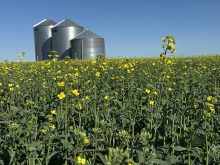Getting semen into the sow at the right moment is the key to successful
insemination.
But knowing that right moment has been a challenge for most pig
producers who use artificial insemination. The onset of estrus does not
give a clear picture of when ovulation will occur. Because of that,
producers often repeatedly inseminate sows to ensure they get pregnant.
That brings with it the risk of decreased farrowing rates, smaller
litter sizes and uterine infections.
Read Also

Huge Black Sea flax crop to provide stiff competition
Russia and Kazakhstan harvested huge flax crops and will be providing stiff competition in China and the EU.
A Dutch scientist recently told Manitoba hog farmers that there is a
more reliable way to predict ovulation, but the producer needs to know
both his herd and each sow. As well, insemination plans are unique to
each farm.
“A strategy that is good for one farm does not have to be good for
another farm,” Nicoline Soede of Wageningen University in The
Netherlands told producers at the Manitoba Swine Seminar.
“There is great variation between farms. The optimal strategy should
vary.”
Soede said insemination needs to occur in the 28 hours before ovulation
or the four hours after ovulation to have a high rate of success.
Fertilization rates drop sharply before and after that period.
However, right now there is no sure-fire way of knowing when ovulation
occurs, Soede said. The average time of ovulation after the onset of
estrus is between 35 and 45 hours, but the range varies from 10 hours
to 85 hours.
That leaves a big window for missing the key opening and a lot of
potential for overinseminating sows.
However, producers can get a good sense of when their sows are going to
ovulate if they know the length of the animals’ estrus. Ovulation
occurs predictably two-thirds of the way through estrus, no matter how
long the estrus is.
And while estrous periods vary wildly between farms, they are much more
predictable within individual farms. The range of estrous periods is
probably caused by a number of factors, Soede said, including barn
conditions, stress levels, the season, the age spread of the sows, and
genetic background.
The weaning-to-estrus interval also tends to have a big effect on the
length of a sow’s estrus, Soede said. Sows with short, three-to-four
day intervals tend to have long estrous periods with comparatively late
ovulation times. Sows with a six day or greater interval have a shorter
estrous period and a comparatively quicker ovulation time.
Within a barn, the sows’ estrous periods will be similar. Knowing the
length of that period can allow producers to more accurately predict
ovulation based on it being two-thirds of the way through, Soede said.
“There is quite a difference between farms,” she said.
Not enough is known about how to pinpoint ovulation to allow producers
to use only one insemination to impregnate a sow, she added.
But the two-thirds prediction method allows producers to more easily
avoid too early or too late inseminations and take advantage of the
ovulation window to get good results.

















